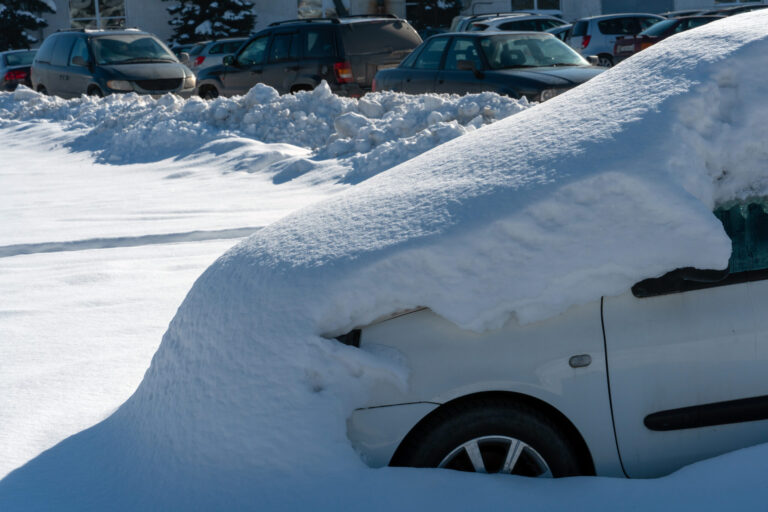5 Methods To Get Unstuck On Ice: Cars And Vehicles

Dealing with icy conditions is a common winter challenge, especially when your vehicle gets stuck. Knowing how to get unstuck on ice is essential for any driver braving the cold months. This guide offers five effective methods to free your vehicle from ice’s grip, discusses the drawbacks of older methods, and recommends using new and more effective solutions to getting your car unstuck.
Assess The Situation
Before attempting to free your vehicle, it’s crucial to assess the situation. Understand how your vehicle is stuck and the condition of the ice around the tires. This assessment will guide your approach and help you choose the most effective method for how to get unstuck on ice.
Clearing Snow And Ice Around The Tires
Start by removing as much snow and ice as you can from around the tires. This action reduces resistance and allows your tires to gain better traction. A shovel or a similar tool can be very useful in this step.
The Ineffectiveness Of Sand And Kitty Litter
Although sand and kitty litter are often recommended for traction, they have significant limitations. Sand can scatter under the vehicle’s weight, providing only temporary traction. Kitty litter, when wet, can turn into a slick mud-like substance, which may worsen the slippery conditions rather than improve them.
Rocking The Vehicle
Gently rocking the vehicle can be an effective way to get unstuck on ice. Alternate between slowly moving forward and reversing to create momentum. This method can help the tires gain enough traction to move the vehicle out of the icy spot.
Get ready for winter with Walk On Ice instant traction on snow and ice
Deflating Tires Slightly
Reducing the tire pressure slightly can increase the tire’s surface area, which might improve traction on the ice. However, remember to reinflate the tires to their correct pressure as soon as you are unstuck to prevent tire damage.
Utilizing Walk On Ice For Immediate Traction
When other methods don’t suffice, Walk On Ice is an excellent solution. It offers instant traction on all icy surfaces, a feature particularly useful when salt and ice melt fail or take time to become effective, especially on black ice. Walk On Ice absorbs the liquid layer of water on the ice, enabling its grippers to lock into the ice and create a stable, non-skid surface.
Benefits Of Walk On Ice Over Traditional Methods
Walk On Ice stands out for its natural composition, making it safe for pets, people, and the environment. Unlike traditional methods, it is effective in temperatures as low as -35 degrees Celsius and does not create a mess or slippery conditions, as kitty litter might. Its natural formula also means it’s safe and easy to handle.
What to Put on Outside Steps to Prevent Slipping in Winter
The discussion doesn’t end with driveways and sidewalks. One of the biggest problem areas in winter is the front steps. People often ask, “what to put on outside steps to prevent slipping in winter?” Salt may seem like an obvious option, but it can damage concrete and wood, not to mention irritate pets’ paws. Sand helps a little, but it scatters and doesn’t always stay where you need it most. Cat litter? As we’ve already covered, it clumps and gets messy fast.
This is where traction-specific products shine. Walk On Ice, for example, works instantly by binding to the ice surface and creating a gritty texture underfoot. Unlike cat litter, it won’t turn to slush when wet. Sprinkling it on your steps means anyone coming to your door—family, delivery drivers, or guests—can walk safely without the risk of sliding.
Slippery Wood Stairs Outdoor: Tackling a Common Hazard
Another spot that deserves special mention is wooden stairs. Once they freeze, they become dangerously slick, often worse than concrete. Many homeowners search for fixes for slippery wood stairs outdoor, only to realize that common solutions don’t last long. Mats get buried in snow, salt damages the wood, and cat litter leaves stains and mushy residue.
Walk On Ice offers a surface-safe alternative. Its mineral-based formula gives you stable traction without harming the wood or leaving behind a mess. Because it absorbs surface moisture and grips at the same time, it provides longer-lasting safety compared to makeshift methods. For families with older adults or young kids, keeping wood stairs safe is one of the most important winter priorities—and using the right traction agent makes it much simpler.
How to Get Your Car Out of Snow Quickly
Of course, winter challenges don’t stop at the doorstep. Getting stuck in snow is another frustration most of us face sooner or later. The question, “how to get your car out of snow” usually comes up after a storm, when tires spin helplessly on ice-packed driveways or parking spots. While some people toss cat litter under the wheels hoping for grip, the reality is it doesn’t hold up—it crumbles and freezes, giving only short-term help.
The better strategy is to clear away excess snow, shift gently between forward and reverse, and add a reliable traction layer under the tires. Walk On Ice was designed for exactly this: its absorbers remove the thin layer of meltwater that makes ice slippery, and its grippers bite down to give tires the grip they need. Keeping a canister in your trunk means you’re ready for these situations without resorting to messy improvisations.
How to Get Your Car Unstuck From Snow: A Smarter Way
Sometimes the car isn’t just sitting on ice—it’s buried in a drift. That’s when the tougher question comes up: “how to get your car unstuck from snow?” In these cases, it’s about combining technique with the right product. Shoveling around the tires helps, but without traction, even the clearest path won’t get you moving.
Spreading Walk On Ice under the drive wheels after each attempt provides the consistent grip needed to climb out of deep snow. Unlike sand or cat litter, it doesn’t blow away or clump up—it stays effective until the car is free. This not only reduces the stress of being stuck but also prevents damage to your driveway and tires from over-spinning. For anyone who drives in snowy regions, this simple preparation can turn a dreaded winter chore into a manageable inconvenience.
Conclusion
So, while cat litter opened the conversation about makeshift traction methods, it quickly becomes clear that it isn’t the answer for every icy challenge. Steps, wooden stairs, and snowbound cars all prove one point: litter wasn’t built for winter safety. Walk On Ice, on the other hand, was. From porches to parking lots, it delivers instant, dependable traction where you need it most—without the mess, damage, or frustration of improvised fixes. Winter throws plenty of surprises, but slipping and spinning don’t have to be among them.
Other Ice Melt Products
Safe Paw
The Original and #1 Selling Pet and Child Safe Ice Melt for over 20 years. Guaranteed environmentally safe – will not harm waterways and sensitive wetlands. All products are made in the USA.

Safe Thaw
Imagine an ice melt you can put down and never worry about. It won’t harm pets, kids, and your property. That’s Safe Thaw. Unlike anything else on the market, Safe Thaw can change how winter affects our planet.



